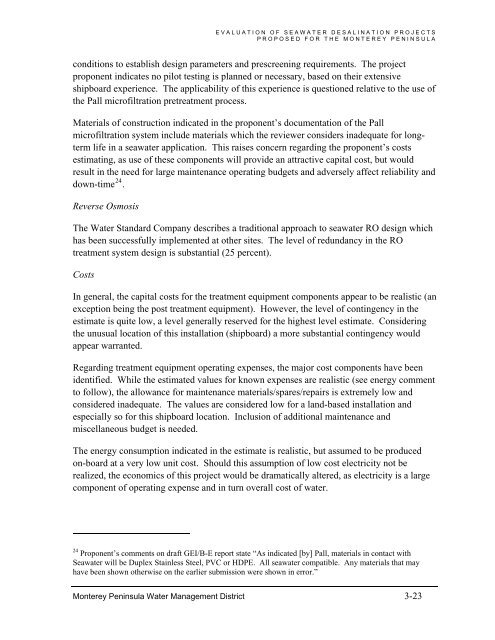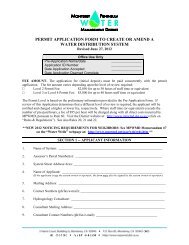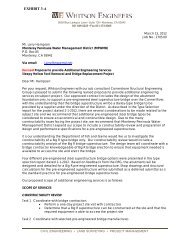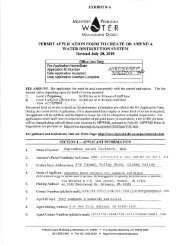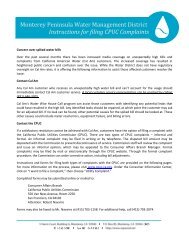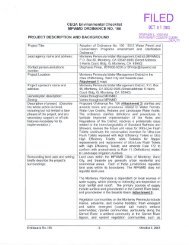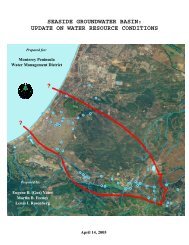FINAL REPORT Evaluation of Seawater Desalination Projects ...
FINAL REPORT Evaluation of Seawater Desalination Projects ...
FINAL REPORT Evaluation of Seawater Desalination Projects ...
Create successful ePaper yourself
Turn your PDF publications into a flip-book with our unique Google optimized e-Paper software.
EVALUATION OF SEAWATER DESALINATION PROJECTS<br />
PROPOSED FOR THE MONTEREY PENINSULA<br />
conditions to establish design parameters and prescreening requirements. The project<br />
proponent indicates no pilot testing is planned or necessary, based on their extensive<br />
shipboard experience. The applicability <strong>of</strong> this experience is questioned relative to the use <strong>of</strong><br />
the Pall micr<strong>of</strong>iltration pretreatment process.<br />
Materials <strong>of</strong> construction indicated in the proponent’s documentation <strong>of</strong> the Pall<br />
micr<strong>of</strong>iltration system include materials which the reviewer considers inadequate for longterm<br />
life in a seawater application. This raises concern regarding the proponent’s costs<br />
estimating, as use <strong>of</strong> these components will provide an attractive capital cost, but would<br />
result in the need for large maintenance operating budgets and adversely affect reliability and<br />
down-time 24 .<br />
Reverse Osmosis<br />
The Water Standard Company describes a traditional approach to seawater RO design which<br />
has been successfully implemented at other sites. The level <strong>of</strong> redundancy in the RO<br />
treatment system design is substantial (25 percent).<br />
Costs<br />
In general, the capital costs for the treatment equipment components appear to be realistic (an<br />
exception being the post treatment equipment). However, the level <strong>of</strong> contingency in the<br />
estimate is quite low, a level generally reserved for the highest level estimate. Considering<br />
the unusual location <strong>of</strong> this installation (shipboard) a more substantial contingency would<br />
appear warranted.<br />
Regarding treatment equipment operating expenses, the major cost components have been<br />
identified. While the estimated values for known expenses are realistic (see energy comment<br />
to follow), the allowance for maintenance materials/spares/repairs is extremely low and<br />
considered inadequate. The values are considered low for a land-based installation and<br />
especially so for this shipboard location. Inclusion <strong>of</strong> additional maintenance and<br />
miscellaneous budget is needed.<br />
The energy consumption indicated in the estimate is realistic, but assumed to be produced<br />
on-board at a very low unit cost. Should this assumption <strong>of</strong> low cost electricity not be<br />
realized, the economics <strong>of</strong> this project would be dramatically altered, as electricity is a large<br />
component <strong>of</strong> operating expense and in turn overall cost <strong>of</strong> water.<br />
24 Proponent’s comments on draft GEI/B-E report state “As indicated [by] Pall, materials in contact with<br />
<strong>Seawater</strong> will be Duplex Stainless Steel, PVC or HDPE. All seawater compatible. Any materials that may<br />
have been shown otherwise on the earlier submission were shown in error.”<br />
Monterey Peninsula Water Management District 3-23


